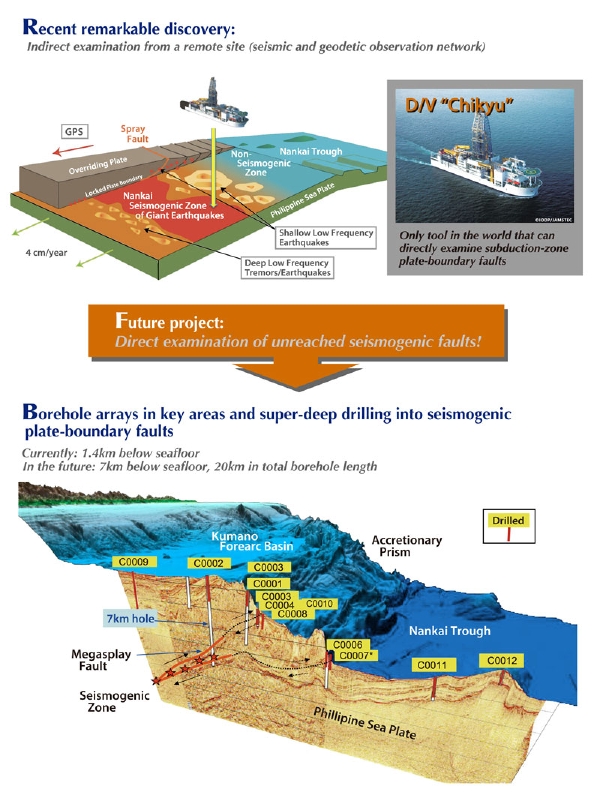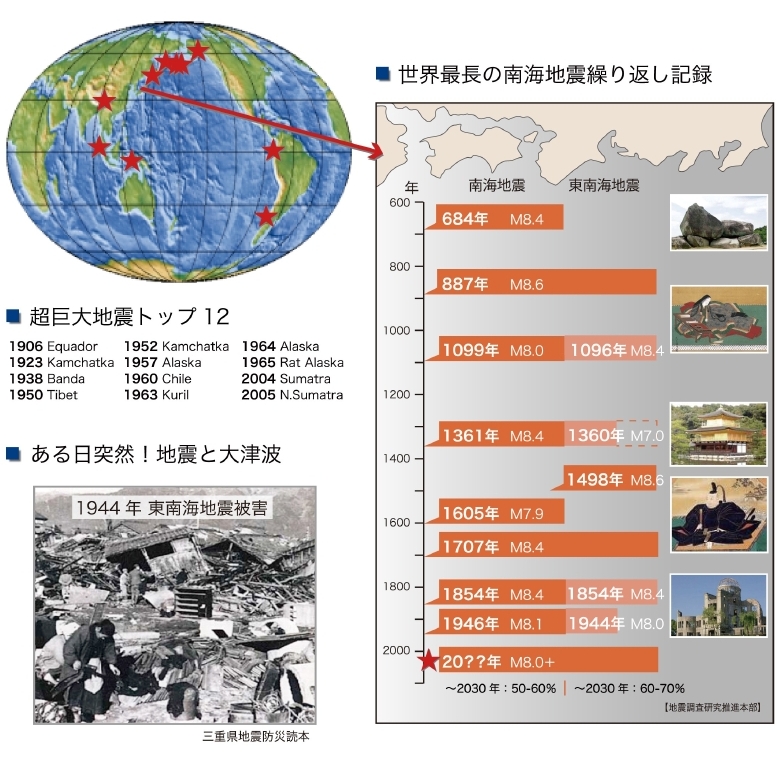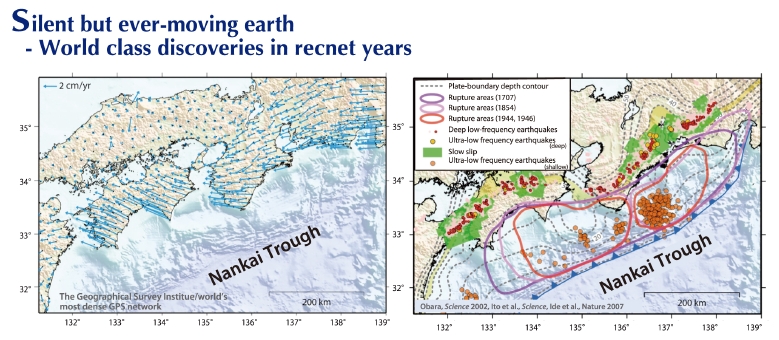Summary
Our scientific objective is to significantly improve the understanding of pre- and co-seismic processes of great subduction-zone earthquakes by directly sampling seismogenic faults and conducting analyses, experiments, and in situ bore-hole measurements at the Nankai Trough region, which is a site where great subduction-zone earthquakes have repeatedly occurred and are expected to occur in the near future.
To realize our goal, our strategy consists of the following three schemes: (1) understanding overall framework of the Nankai Trough seismogenic zone, (2) revealing materials, and mechanical and hydrologic properties of seismogenic faults, and (3) construction and verification of a comprehensive model for pre- and co-seismic processes. We have organized three research groups dedicated to these three schemes, each of which further consists of two sub-groups tackling two complementary tasks. We will complete those tasks in the next five years.

Background
Background
Giant subduction-zone earthquakes and their accompanying tsunamis have caused massive damage in the past. In the Nankai region off southwestern Japan, giant earthquakes with magnitudes as large as 8 have been recorded every 100-200 years. The probability of another great earthquake in the next 30 years is 50-70% and the likelihood by the end of the century is almost 100%.

To detect active crustal movements in the Nankai Trough region, densely distributed monitoring systems are currently being set up. These include “Evaluation study of inter-triggering among Tokai, Tonankai and Nankai earthquakes” and “Observation and monitoring system of earthquakes and tsunamis” by Japanese Ministry of Education, Culture, Sports, Science and Technology, “High sensitivity seismograph network of Japan (Hi-net)”, “Full range seismograph network of Japan (F-net)”, “Kyoshin Net (K-NET)” and “Kiban-Kyoshin Net (KiK-net)” by National Research Institute for Earth Science and Disaster Prevention, “GPS earth observation network system (GEONET)” by Geographical Survey Institute, distribution of cabled ocean bottom seismographs by Japan Meteological Agency, and installation of groundwater-monitoring observatories by National Institute of Advanced Industrial Science and Technology.

Related recent studies
In addition to the above remote monitoring studies, earthquake studies employing novel techniques have recently emerged in Japan and other countries. These include drilling into and sampling earthquake faults at depths, analyses and experiments of sampled fault materials, and borehole measurements at depths.
The first earthquake fault drilled was the Nojima Fault, which slipped during the 1995 Kobe Earthquake, and the second one was the Chelunpu Fault, which slipped during the 1999 Chichi Earthquake. These studies have revealed post-seismic strength recovery, co-seismic heat generation and subsequent cooling, and variable slip-weakening mechanisms. However, these drillings were much shallower than seismogenic depths and were conducted after those earthquakes. Hence, the actual process prior to an earthquake remains to be clarified.
In the United States, drilling down to seismogenic depths is currently in progress along the San Andreas Fault, which is a transform plate boundary along the west coast of the North America. In July 2005 the drilling penetrated the fault at the depth of 3000 m, and successfully sampled the fault in September 2007. Continuous borehole measurements are now planned at this site.
To date, super-deep drilling down to seismogenic faults along a subduction zone has yet to be conducted, and thus, was identified as one of the most important scientific targets of the Integrated Ocean Drilling Program (IODP) launched in 2003. The Nankai Trough seismogenic zone experiment (NanTroSEIZE) using a riser drilling vessel “Chikyu” was approved by IODP and began in 2007. NanTroSEIZE aims to drill through the seismogenic plate-boundary and mega-splay faults at a depth of ca. 6 km below seafloor by 2012. Our project strives to achieve a comprehensive understanding of processes prior to and during subduction-zone earthquakes through this super-deep drilling, and is recognized as a cutting-edge subduction-zone earthquake study.


 HOME
HOME KANAME Office
KANAME Office